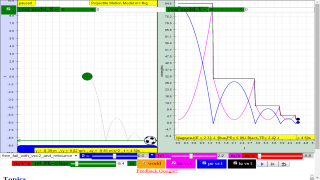About
Topics
Energy formsEnergy conversion
Takeaways:
Energy makes changes and movement possible in everyday lifeEnergy is required to enable things to work or move.
There are different forms of energy and they can be converted from one form to another.
Description
This simulation allow students to explore the concepts of kinetic energy and potential energy. When the re-bounce case is selected, the sum of kinetic energy and potential energy drop immediately after each contact with the ground. The energy loss is typically associated with sound and heat energy loss to the surrounding by the ball.Sample Questions that this simulations was made to address
Sample Learning Goals
**Recognise and give examples of the various forms of energy. - kinetic energy - potential energy**Investigate energy conversion from one form to another and communicate findings.
Version:
- http://weelookang.blogspot.sg/2014/09/ejss-projectile-customized-after.html
- http://weelookang.blogspot.sg/2014/08/brown-bag-in-time-in-tune-lunch-time.html
- http://weelookang.blogspot.sg/2014/05/ejss-projectile-motion-model-for.html
- http://weelookang.blogspot.sg/2013/12/ejss-free-fall-model.html
ball taken from: http://psychology.wikia.com/wiki/File:Soccer_ball.svg
http://weelookang.blogspot.sg/2014/09/ejss-projectile-customized-after.html
http://weelookang.blogspot.sg/2013/12/ejss-free-fall-model.html sound effects from http://www.freesfx.co.uk/sfx/bouncing
For Teachers
Teacher-Submitted Activities
|
Title |
Authors |
Level |
Type |
Updated |
Share an activity! email
Translations
| Code | Language | Translator | Run | |
|---|---|---|---|---|
 |
||||
Credits

This email address is being protected from spambots. You need JavaScript enabled to view it.; Tan Seng Kwang slighted edited
Briefing Document: Secondary Projectile Motion Energy Model
1. Overview
This document analyzes an online resource focused on a "Secondary Projectile Motion Energy Model," utilizing a JavaScript simulation to explore concepts of kinetic and potential energy. The resource is part of the Open Educational Resources / Open Source Physics @ Singapore initiative. It provides interactive tools for students and educators to investigate energy transformations in projectile motion. The resource emphasizes hands-on learning and aims to help students grasp fundamental physics principles through experimentation and visualization.
2. Key Themes and Concepts
- Energy Forms and Transformations: The core concept is the exploration of kinetic energy (energy of motion) and potential energy (energy of position). The simulation is designed to demonstrate how these forms of energy convert into one another. As stated in the "Takeaways":
- "Energy makes changes and movement possible in everyday life."
- "Energy is required to enable things to work or move."
- "There are different forms of energy and they can be converted from one form to another."
- Kinetic and Potential Energy in Projectile Motion: The simulation visualizes how kinetic and potential energy change during different types of projectile motion:
- Free Fall: Kinetic energy increases as the object falls, while potential energy decreases.
- Toss Up: Kinetic energy decreases as the object goes up, being converted to potential energy which increases until the object reaches its highest point. The opposite happens during the descent.
- Rebounce: The simulation also demonstrates how energy is lost as heat and sound when a ball bounces, as the sum of kinetic and potential energy drops immediately after each impact with the ground.
- Total Energy: The resource emphasizes that in the absence of energy loss, the total energy (kinetic + potential) of a system remains constant. As the included suggested answer states, "ke + pe = te."
- Importance of the Reference Point: The simulation allows the user to alter the reference line for potential energy, demonstrating that while potential energy is dependent on the chosen reference point, kinetic energy is not affected by it.
- "reference PE = 0 is a imaginary line for which potential energy is calculated referencing from. ke is not affected by “ref. PE=0 line”
- Mathematical Modeling: The resource encourages students to investigate the relationships between variables, specifically between speed and kinetic energy. It aims to guide students to develop a model or mathematical representation for kinetic energy:
- "by observing the data is the table, suggest a viable equation-model for ke in terms of v. suggested answer ke = 0.5*v^2"
- It encourages students to refine models and understand the importance of a complete model:
- "??, ke = 0.5v^2 is incomplete, the complete equation is ke = 0.5m*v^2 where m is the mass of the object."
3. Simulation Features and Activities
- Interactive Simulation: The core of this resource is an interactive JavaScript simulation. This allows students to:
- Control initial conditions (initial velocity of a ball).
- Visualize the motion of the object (football).
- Simultaneously observe the corresponding kinetic energy (ke), potential energy (pe) and total energy (te) graphs.
- Pause, play, and reset the simulation.
- Pre-set Motions: The simulation includes pre-set scenarios (free fall, toss up, user-defined, free fall and rebounce) that let students easily explore various energy transfer behaviors.
- Data Collection and Analysis: The simulation facilitates data collection (speed and kinetic energy) that is used to create a relationship between them through filling a provided table.
- Guiding Questions: The provided activities prompt students to analyze the relationship between ke, pe, and total energy, and their dependence or independence of the reference line.
- Examples of questions include "What do you notice about the graphs?" and "How are the ke and pe graphs different?"
- Modeling Exercises: The resource provides exercises that encourage students to derive mathematical models from the observed data.
4. Target Audience
This resource is specifically designed for secondary-level students learning about projectile motion, energy, and energy transformation. It could also be useful for introductory physics courses at higher levels. The resource also provides "For Teachers" sections, including teacher-submitted activities and links to further resources.
5. Educational Approach
- Inquiry-Based Learning: The resource promotes student-led inquiry, encouraging them to explore, experiment, and draw their own conclusions about the principles of energy.
- Visual Learning: The graphical representation of energy transformation is designed to make the concepts clearer for visual learners.
- Interactive Learning: The hands-on aspect of the simulation is intended to engage students and make the learning experience more interactive and memorable.
6. Key Takeaways for Educators
- This simulation can serve as a valuable tool for teaching energy concepts in a visual and engaging way.
- The focus on modeling encourages a deeper understanding of physics principles.
- The inclusion of teacher resources provides support for integrating the simulation into a broader curriculum.
- The various pre-set motion options make it easy to illustrate key concepts in different situations.
7. Links to Other Resources
The document provides links to:
- Multiple versions of the simulation.
- Related blog posts.
- Various other simulations and educational resources.
- Open Source Physics Project details.
8. Conclusion
The "Secondary Projectile Motion Energy Model" simulation provides a valuable tool for teaching and learning about energy transformations in the context of projectile motion. Its focus on interactive exploration, visual representation, and mathematical modeling makes it an effective resource for secondary physics education. The emphasis on inquiry-based learning and the availability of teacher resources make it easy to integrate into a variety of educational settings.
Projectile Motion & Energy Study Guide
Quiz
Instructions: Answer each question in 2-3 complete sentences.
- What are the two primary forms of energy discussed in the simulation?
- What happens to the total energy of the ball when the "re-bounce" case is selected, and what accounts for this change?
- According to the simulation's learning goals, what are students expected to recognize and identify?
- In the “free_fall” setting, how do kinetic energy and potential energy change as the object moves?
- How does the potential energy graph differ when the simulation is set to “toss_up” compared to “free fall?”
- What is the relationship between kinetic energy (KE), potential energy (PE), and total energy (TE) in the simulation?
- What does the "ref. PE=0 line" represent, and how does it affect the energy graphs?
- Based on the table provided, what was the suggested relationship between speed (v) and kinetic energy (ke)?
- How did the "free_fall_and_rebounce" setting test the established rules for kinetic and potential energy, and what adjustment to the formula was suggested?
- Beyond physics, what other areas of study does the website appear to engage with or support?
Quiz Answer Key
- The two primary forms of energy discussed in the simulation are kinetic energy, the energy of motion, and potential energy, the energy stored due to an object's position. These forms of energy are interconvertible.
- When the "re-bounce" case is selected, the total energy of the ball drops immediately after each contact with the ground. This loss of energy is primarily due to the conversion of mechanical energy into heat and sound, which dissipates into the surroundings.
- Students are expected to recognize and give examples of the various forms of energy, specifically kinetic energy and potential energy. They should also be able to investigate the conversion of energy from one form to another and communicate their findings.
- In the “free_fall” setting, kinetic energy increases from zero at an increasing rate as the object falls. Potential energy decreases at a decreasing rate, starting from its maximum, as the object falls.
- When set to “toss_up,” the kinetic energy graph decreases initially, reaching its minimum at the peak of the toss before increasing again, while potential energy increases initially, reaching a maximum at the peak before decreasing. This differs from “free_fall,” where kinetic energy only increases and potential energy only decreases.
- The total energy (TE) in the simulation is the sum of kinetic energy (KE) and potential energy (PE); thus, KE + PE = TE. This demonstrates that while KE and PE may change in relation to one another, the total energy is conserved.
- The "ref. PE=0 line" is an imaginary line from which potential energy is calculated. Changing the position of the line does not affect the kinetic energy graph but it will change the potential energy graph.
- Based on the data provided in the table, the relationship between speed (v) and kinetic energy (ke) was suggested to be ke = 0.5*v^2. This demonstrates that kinetic energy is dependent on the square of the speed.
- The "free_fall_and_rebounce" setting demonstrated that while the total energy is still KE + PE, the suggested formula, ke = 0.5v^2, is incomplete, and requires the inclusion of mass as part of the complete formula which is ke = 0.5m*v^2.
- The website engages with a wide array of topics, including mathematics, chemistry, and technology, in addition to physics. It also includes resources for art and music, among other subjects.
Essay Questions
Instructions: Answer each question with a well-organized essay that synthesizes information from the provided source material.
- Analyze the role of the simulation in helping students understand the concepts of kinetic energy and potential energy, including how different settings can illustrate these concepts. Discuss how this interactive approach enhances learning compared to traditional methods.
- Discuss the importance of the “ref. PE=0 line” in the simulation and how it relates to the calculation and interpretation of potential energy. How does manipulating this reference point influence student understanding of energy concepts?
- Examine the relationship between kinetic energy, potential energy, and total energy as presented in the simulation. Explain the concept of energy conservation as demonstrated through the various settings, and how the "free_fall_and_rebounce" setting highlights the complexities of energy transfer.
- Evaluate the use of simulations and modeling as a pedagogical tool, citing examples from the resource material. Discuss the benefits of using simulations in education, including active learning and student engagement, as well as how they might assist in understanding abstract ideas in physics and other areas.
- Consider the broader educational resources provided by the website. What is the advantage of this multidisciplinary approach, and how do these additional materials enhance the learning experience? Discuss the potential benefits of open educational resources such as this one, in education.
Glossary of Key Terms
Kinetic Energy: The energy an object possesses due to its motion, calculated as 1/2 * mass * velocity squared.
Potential Energy: The energy an object possesses due to its position or configuration, often related to its height in a gravitational field or the compression/extension of a spring.
Total Energy: The sum of all forms of energy in a system, often the sum of kinetic and potential energy. In a closed system, the total energy remains constant (conservation of energy).
Energy Conversion: The process of changing energy from one form to another, for example, from potential energy to kinetic energy.
Free Fall: The motion of an object under the influence of gravity alone, with no other forces acting on it (e.g., air resistance).
Reference Line (ref. PE=0 line): An arbitrary line or point from which potential energy is measured; changing this reference point does not affect the changes in potential energy, only the absolute value.
Model: A simplified representation or description of a system or process, used to explain or predict its behavior, such as in the kinetic energy equation provided: ke = 0.5mv^2.
Simulation: A computer-based representation of a system or process that allows users to manipulate variables and observe the effects.
Open Educational Resources (OER): Teaching and learning materials that are freely available online for anyone to use, often under a Creative Commons license.
Pedagogical Tool: Any resource or method used by educators to facilitate learning.
Sample Learning Goals


For Teachers
Activity 1
INVESTIGATE
Go to the following simulation: http://tinyurl.com/ast2016-3 
The left panel shows a football being given an initial velocity. This could be zero (the ball is being dropped), upwards (tossed up) or horizontal (thrown horizontally).
The right panel allows you to plot the energy of the object over time. The default is a plot for kinetic energy (ke), but you can also request potential energy (pe), and total energy (te). Remember that you can play the simulation by clicking the appropriate button (►). Click the pause button ( ▌▌) to pause the simulation.
- First select the “free_fall” setting, using the yellow drop-down box in the bottom panel. Watch the ke and pe graphs as the object moves. What do you notice about the graphs?
- suggested answer: kinetic energy increases from t = 0 , KE = 0 J at an increasing rate. Potential energy decreases from t = 0 s, PE = maximum J at an decreasing rate as shown in the sketch.
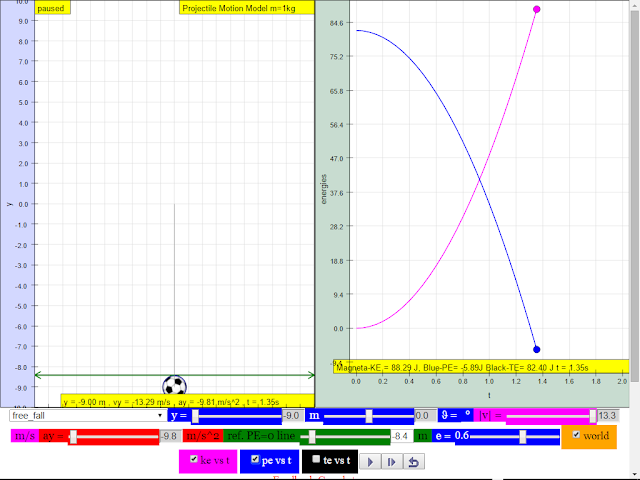
- suggested answer: kinetic energy increases from t = 0 , KE = 0 J at an increasing rate. Potential energy decreases from t = 0 s, PE = maximum J at an decreasing rate as shown in the sketch.
- Now try the “toss_up” setting. How are the ke and pe graphs different?
- suggested answer: kinetic energy decreasing from t = 0 , KE = 50 J at an decreasing rate until t =1 s. From t >1 s, Kinetic energy increases at an increasing rate. Potential energy increases from t = 0 s to 1 s. From t>1 s, PE decreases at decreasing rate as shown in the sketch.
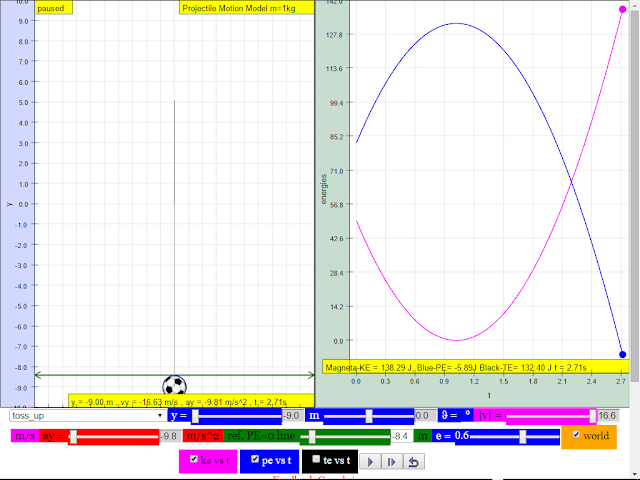
- suggested answer: kinetic energy decreasing from t = 0 , KE = 50 J at an decreasing rate until t =1 s. From t >1 s, Kinetic energy increases at an increasing rate. Potential energy increases from t = 0 s to 1 s. From t>1 s, PE decreases at decreasing rate as shown in the sketch.
- Select total energy te checkbox, suggest an big idea relating ke and pe to te.
- suggested answer: ke + pe = te
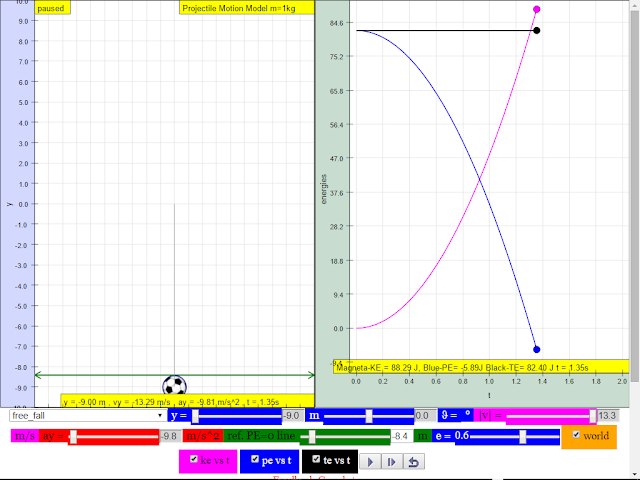
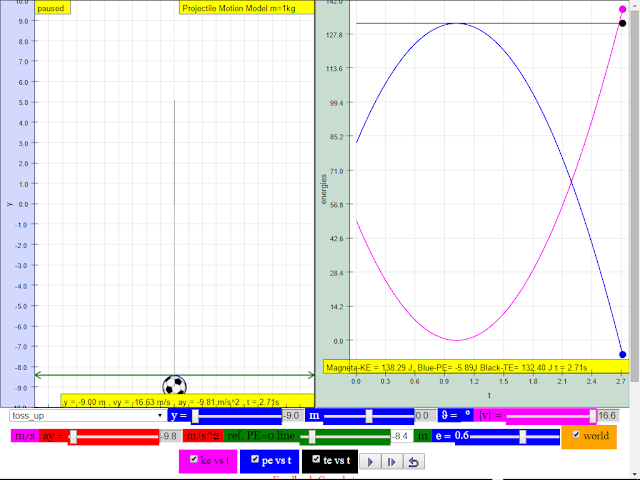
- suggested answer: ke + pe = te
- You can alter the reference line for this simulation. Reset the simulation for “free_fall” or for “toss_up” but, before you press play, change the “ref. PE=0 line” to a different value.
How are the ke and pe graphs different when you choose a different PE reference line?- suggested answer: reference PE = 0 is a imaginary line for which potential energy is calculated referencing from. ke is not affected by “ref. PE=0 line”
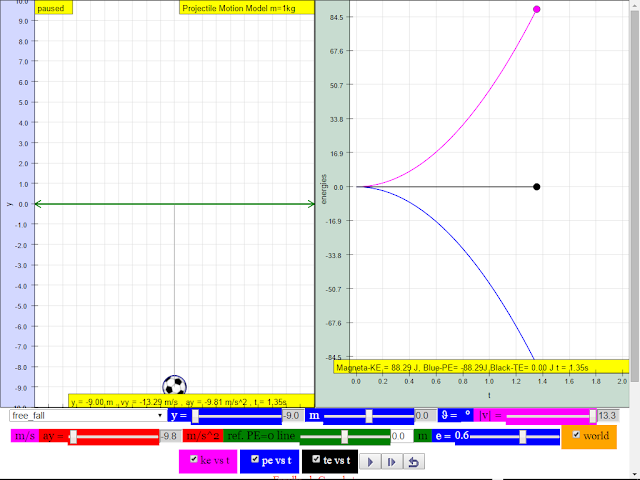

- suggested answer: reference PE = 0 is a imaginary line for which potential energy is calculated referencing from. ke is not affected by “ref. PE=0 line”
MODEL
You may have noticed that the kinetic energy ke depends on the speed |v|. Now set the simulation to “user_defined”. You can choose the speed you want by typing the value in the magenta box in the bottom. You can read the corresponding kinetic energy ke in the yellow box below the graph in the right-hand panel. Try to fill up the table below.
| Speed |v| in m/s | Speed x Speed (v2) | Kinetic energy ke in J |
|
0.00
|
||
|
1.00
|
||
|
2.00
|
||
|
3.00
|
9.00 | |
|
4.00
|
||
|
5.00
|
12.5 |
Now that you have investigated some of the different motions of the football, let’s try to model this by creating some rules about pe and ke. Note that the mass of the ball in the simulation is 1.00 kg, as indicated in the yellow box above the image on the left.
by observing the data is the table, suggest a viable equation-model for ke in terms of v.
suggested answer ke = 0.5*v^2
- Write down some rules for the relationships between pe and ke. Here’s an example:
ke + pe = te
the value of pe is measured from the PE reference line
“The graph for ke does not depend on the PE reference line.”
APPLY
Now try to test your model to see if your rules hold true for a different pre-set motion: “free_fall_and_rebounce”.
- Which of your rules are still the same after trying the “free_fall_and_rebounce” setting?
- ke +pe = te
- the value of pe is measured from the PE reference line
- Which of the rules were not retained?
- ??, ke = 0.5*v^2 is incomplete, the complete equation is ke = 0.5*m*v^2 where m is the mass of the object.
Worksheets
-
Research
[text]
Video
Version:
Other Resources
[text]
Project related:
Understanding Teacher Learning Community as Support for Implementation of Open Source Physics for Conceptual Instruction
Project Number: OER 10/15 GWF
Project Duration: 01 July 2015 - 30 April 2017
http://weelookang.blogspot.sg/2015/07/understanding-teacher-learning.html
FAQ: Projectile Motion and Energy
- What are the main forms of energy explored in the projectile motion simulation? The simulation primarily focuses on two forms of energy: kinetic energy (KE), which is the energy of motion, and potential energy (PE), which is the energy stored due to an object's position or condition. Specifically, the simulation deals with gravitational potential energy, which is based on an object's height relative to a chosen reference point.
- How does the simulation demonstrate energy conversion? The simulation allows users to observe how kinetic and potential energy are converted into one another during projectile motion. For example, when a ball is tossed upward, its initial kinetic energy is converted to potential energy as it rises, slowing down. As the ball falls, the process reverses, with potential energy converting back into kinetic energy causing the ball to accelerate downwards.
- What happens to total energy in the simulation, especially in the "rebounce" scenario? In the absence of energy loss to the environment, the total energy (TE), which is the sum of kinetic energy (KE) and potential energy (PE), remains relatively constant throughout the projectile motion (KE + PE = TE). However, when the "rebounce" option is selected, the total energy decreases each time the ball impacts the ground. This energy loss is attributed to energy being converted to heat and sound, dissipating into the surroundings.
- How does changing the reference line for potential energy affect the graphs in the simulation? Changing the reference line for potential energy (PE=0 line) only affects the potential energy graph. The kinetic energy graph remains unchanged because kinetic energy depends only on the object's speed, not its vertical position relative to an arbitrary zero point. The PE graph will shift up or down depending on the change to the reference line, but the change in potential energy will remain the same, meaning the overall shape of the graph doesn't change.
- How can the simulation be used to derive the formula for kinetic energy? By using the "user_defined" setting to alter the initial speed of the ball, users can observe the corresponding kinetic energy changes, and a pattern will appear which demonstrates the mathematical relationship between kinetic energy and the square of the speed of the ball. More precisely, if the mass of the ball is 1 kg, it can be shown that KE=0.5*v^2. If the user does not set the ball mass to 1kg in the simulation, a pattern will emerge that KE = 0.5 * m * v^2
- What is the key mathematical relationship between kinetic energy (KE), potential energy (PE) and total energy (TE) in this model? The key relationship demonstrated by the simulation is the principle of conservation of energy. In situations where there are no energy losses to the environment, the sum of kinetic energy (KE) and potential energy (PE) equals the total energy (TE), i.e., KE + PE = TE. This relationship holds true even when energy is converted back and forth between KE and PE, and can be seen in the KE/PE graph.
- What types of motion can be explored using this simulation? The simulation is designed to explore various types of projectile motion, including free fall (vertical motion under gravity), tossing objects vertically, and throwing objects horizontally. Users can also define the initial velocity to observe how different starting conditions affect the energy dynamics, and observe the energy transformations within those scenarios. The simulation also includes a rebounce option.
- What are some of the ways this simulation can be used as a learning tool? This simulation is a versatile tool for learning about energy in physics. It provides visual representations of energy changes during projectile motion, including the graph of energy over time. It allows for exploration of different parameters like initial velocity and a reference line, aiding in the construction of mental models for understanding energy concepts and their applications. Students can also experiment and discover, for example, that kinetic energy is equal to half the mass times the square of the speed. This promotes active learning, conceptual understanding, and critical thinking skills.
- Details
- Parent Category: 04 Energy & Fields
- Category: 07 Energy Work Power
- Hits: 8088


